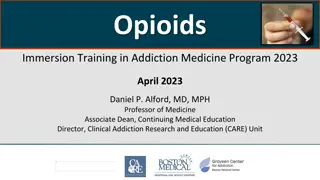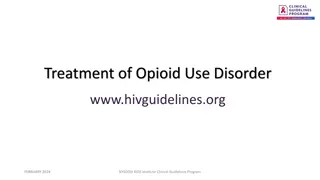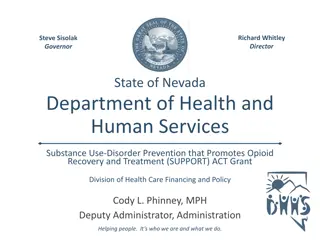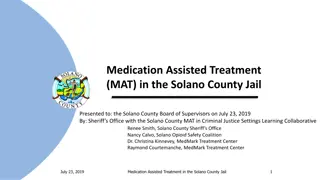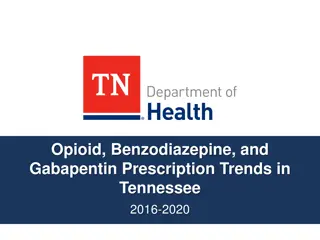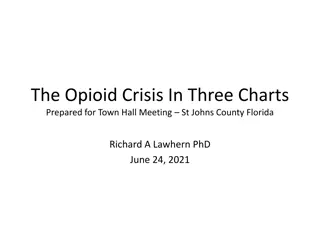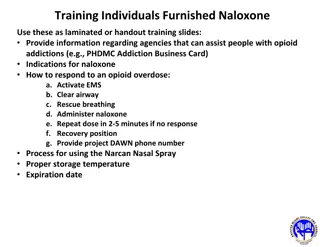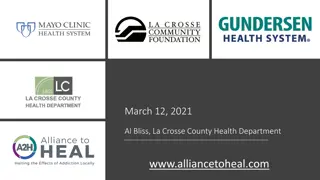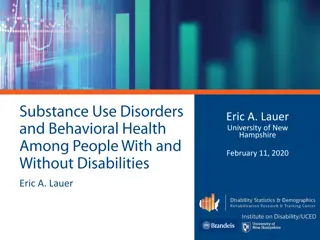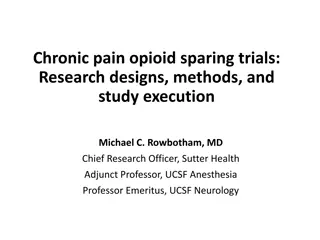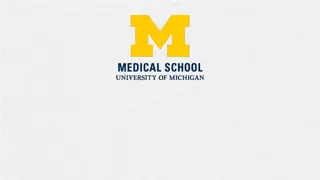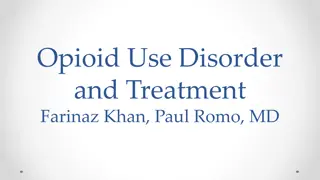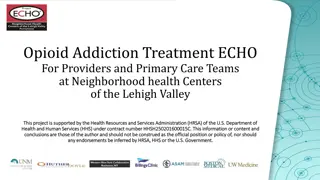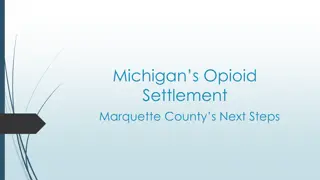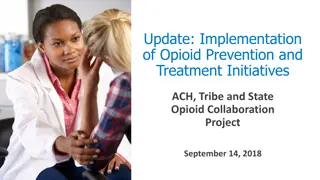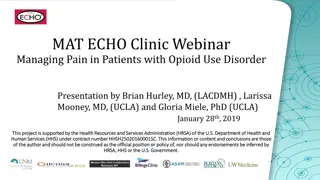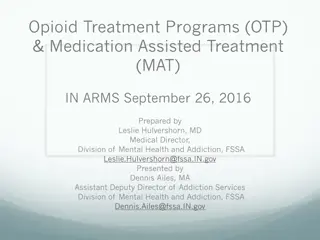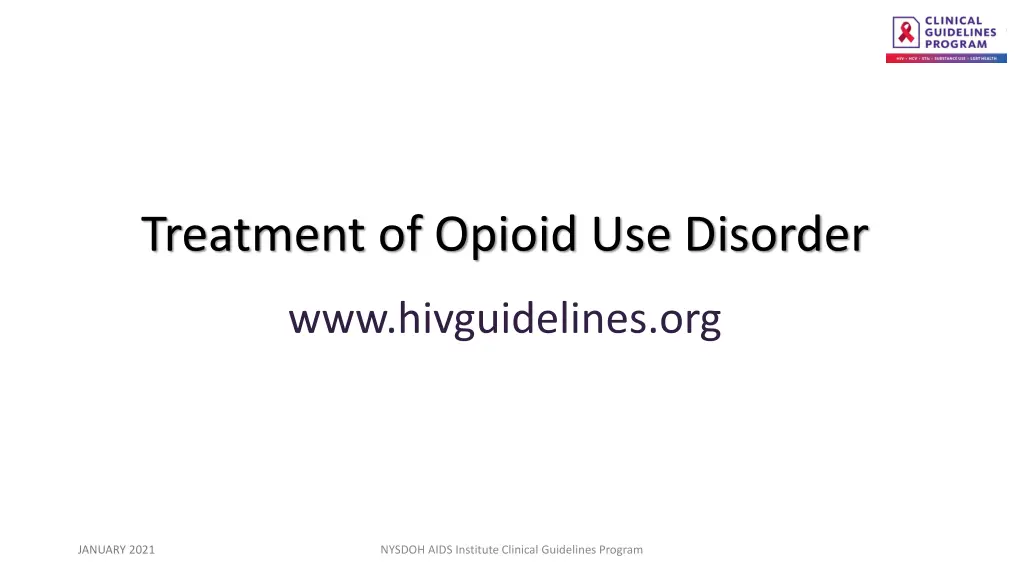
Evidence-Based Treatment Guidelines for Opioid Use Disorder
Explore the January 2021 NYSDOH AIDS Institute Clinical Guidelines Program focusing on evidence-based treatment for individuals with opioid use disorder. The guidelines aim to increase clinician engagement, improve patient outcomes, reduce opioid-related overdoses, and promote harm reduction strategies. Learn about pharmacologic treatment, harm reduction approaches, and the importance of long-term care for this chronic condition.
Download Presentation

Please find below an Image/Link to download the presentation.
The content on the website is provided AS IS for your information and personal use only. It may not be sold, licensed, or shared on other websites without obtaining consent from the author. If you encounter any issues during the download, it is possible that the publisher has removed the file from their server.
You are allowed to download the files provided on this website for personal or commercial use, subject to the condition that they are used lawfully. All files are the property of their respective owners.
The content on the website is provided AS IS for your information and personal use only. It may not be sold, licensed, or shared on other websites without obtaining consent from the author.
E N D
Presentation Transcript
Treatment of Opioid Use Disorder www.hivguidelines.org JANUARY 2021 NYSDOH AIDS Institute Clinical Guidelines Program
Purpose of This Guideline Purpose of This Guideline Increase the number of clinicians in outpatient settings offering evidence- based treatment to individuals with opioid use disorder. Increase the number of New York State residents with opioid use disorder who are engaged in treatment. Reduce the number of opioid-related overdoses and deaths in New York State. Promote a harm reduction approach to treatment of all SUDs, which involves practical strategies and ideas aimed at reducing the negative consequences associated with opioid use. See the NYSDOH AI guideline Substance Use Harm Reduction in Medical Care. JANUARY 2021 NYSDOH AIDS Institute Clinical Guidelines Program www.hivguidelines.org
Definition of Terms Definition of Terms Term Definition Substance use Alcohol or drug use Illicit drug use Use of non-prescription medication or drug Substance use disorder (SUD) Diagnostic and Statistical Manual of Mental Disorders, Fifth Edition (DSM-5) diagnosis SUD treatment Pharmacologic, psychosocial, or harm reduction intervention for individuals with SUD Pharmacologic treatment Replaces medication-assisted treatment (MAT) Medication Pharmacologic agent used to treat SUD (e.g., methadone) Harm reduction In the clinical context, harm reduction is an approach and a set of practical strategies targeted to reduce the negative consequences associated with substance use. It is founded on respect for and the rights of those individuals who use drugs. JANUARY 2021 NYSDOH AIDS Institute Clinical Guidelines Program www.hivguidelines.org
Goals of Treatment Goals of Treatment Staying engaged in care, which can also facilitate prevention, diagnosis, and treatment of other conditions. Reducing opioid use. Reducing high-risk behaviors, such as injection drug use and sharing of injection equipment, and reducing related complications, such as infection and overdose. Improving quality of life and other social indicators, such as employment, stable housing, and risk of incarceration. JANUARY 2021 NYSDOH AIDS Institute Clinical Guidelines Program www.hivguidelines.org
Recommendations: Recommendations: Pharmacologic Treatment Pharmacologic Treatment Clinicians should offer pharmacologic treatment to all patients with opioid use disorder. (A1) Clinicians should not exclude patients from pharmacologic treatment due to lack of participation in structured psychosocial therapy, such as general counseling, cognitive behavioral therapy, or contingency management. (A1) Note: If a patient is court-ordered to participate in psychosocial therapy, the clinician providing pharmacologic treatment should partner with the patient to ensure compliance with the court order. Clinicians should not exclude patients from pharmacologic treatment solely due to co-occurring substance use disorder(s) or other substance use. (A2) Because opioid use disorder is a chronic condition, clinicians should recommend long-term pharmacologic treatment, which, in some cases, may be lifelong. (A1) Clinicians should offer pharmacologic treatment to patients with opioid use disorder who are not actively using opioids but are at risk of relapse or overdose. (B3) Before a patient with opioid use disorder who has been treated for an opioid overdose or a complication related to opioid use leaves an acute care setting, clinicians should initiate or recommend pharmacologic treatment. (A1) Clinicians should provide or prescribe naloxone to all patients with opioid use disorder so they are prepared in case of an opioid overdose (A2) and should encourage patients to have their partners, families, and household or other close contacts trained to use naloxone. (A3) JANUARY 2021 NYSDOH AIDS Institute Clinical Guidelines Program www.hivguidelines.org
Key Points: Key Points: Pharmacologic Treatment Pharmacologic Treatment The harm of not treating OUD outweighs the risk of adverse events that may be associated with concurrent use of alcohol or benzodiazepines and methadone or BUP. Patients who are seen in EDs or other acute care settings for opioid overdose or complications related to opioid use are at risk of a fatal overdose. Pharmacologic treatment for OUD should be initiated or recommended before the patient leaves the acute care setting. In addition, NLX should be dispensed or prescribed. Medical settings should offer all pharmacologic OUD treatment options allowed under state and federal regulations. Pharmacologic treatment for OUD with BUP/NLX, other formulations of BUP, and extended-release (XR) naltrexone does not require specialized substance use care or clinics. These medications can be prescribed by medical providers in nonspecialized settings and, ideally, integrated into primary care practice. JANUARY 2021 NYSDOH AIDS Institute Clinical Guidelines Program www.hivguidelines.org
Recommendations: Recommendations: Treatment Options Treatment Options Clinicians should inform patients with opioid use disorder about all available pharmacologic options (buprenorphine, methadone, and extended-release injectable naltrexone) and all formulations. (A3) Clinicians should recommend coformulated buprenorphine/naloxone or methadone as preferred treatments for individuals with opioid use disorder. (A3) Clinicians and patients should choose the pharmacologic medication for opioid use disorder based on: (A3) Patient opioid tolerance and prior treatment experiences Available formulations and adverse effects Evidence of effectiveness of the different treatment options Ease of access Presence of other medical conditions Insurance coverage Patient preference JANUARY 2021 NYSDOH AIDS Institute Clinical Guidelines Program www.hivguidelines.org
Recommendations: Recommendations: Treatment Options Treatment Options, continued If individuals who are treated for opioid use disorder with buprenorphine/naloxone or extended-release naltrexone require opioid analgesics for pain management, clinicians should: (B3) Refer patients to methadone treatment. If methadone treatment is not available, consult or refer patients to an experienced substance use treatment or pain management provider. If individuals have continued symptoms of opioid withdrawal or cravings on a maximum dose of buprenorphine 24 mg/naloxone 6 mg per day, taken as one dose or split into two doses, clinicians should: Refer patients to methadone treatment. (A3) If methadone treatment is not available, consult or refer patients to an experienced substance use treatment provider. (A3) Clinicians should offer extended-release naltrexone to patients who prefer naltrexone for treatment or who are not able to access treatment with or reach their treatment goals with methadone or buprenorphine/naloxone. (A3) JANUARY 2021 NYSDOH AIDS Institute Clinical Guidelines Program www.hivguidelines.org
Recommendations: Recommendations: Buprenorphine/Naloxone (Preferred) Buprenorphine/Naloxone (Preferred) Because initiation of buprenorphine/naloxone treatment may induce precipitated withdrawal, clinicians should verify by observation or patient report that a patient is already experiencing signs and symptoms of opioid withdrawal before starting treatment. (A2) Clinicians should titrate a patient s dose of buprenorphine/naloxone to the dose needed to control the patient s opioid cravings, reduce or prevent withdrawal symptoms, and support the individual s treatment goals. (A3) Because home-based, unobserved buprenorphine/naloxone induction and office-based, observed induction are equally effective, clinicians should choose an induction approach based on patient and healthcare provider experience, comfort, and preferences. (B2) If tapering buprenorphine/naloxone treatment, clinicians should: Inform patients about the risks of recurrence of use, reduced tolerance, and opioid overdose. (A3) Offer patients a slow tapering schedule to minimize withdrawal symptoms. (B3) JANUARY 2021 NYSDOH AIDS Institute Clinical Guidelines Program www.hivguidelines.org
Recommendation: Recommendation: Methadone (Preferred) Methadone (Preferred) Because methadone cannot be prescribed in an office-based setting for treatment of opioid use disorder, clinicians should recommend and refer a patient to a methadone maintenance treatment program if the patient: (A3) Prefers methadone treatment. Cannot access buprenorphine/naloxone. Has continued symptoms of opioid withdrawal or cravings while on the maximum dose of buprenorphine/naloxone 24 mg/6 mg daily. JANUARY 2021 NYSDOH AIDS Institute Clinical Guidelines Program www.hivguidelines.org
Recommendations: Recommendations: Naltrexone (Alternative) Naltrexone (Alternative) When informing patients about extended-release naltrexone as a treatment option, clinicians should emphasize the strong motivation and adherence required for success. (B1) Before administering extended-release naltrexone, clinicians should administer a naloxone challenge, and confirm that the patient has no reaction, to ensure that opioids have been cleared from the system. (A2) JANUARY 2021 NYSDOH AIDS Institute Clinical Guidelines Program www.hivguidelines.org
Key Points: Key Points: Implementing Opioid Use Disorder Treatment Implementing Opioid Use Disorder Treatment Clinicians qualified to offer BUP in New York State (NYS) can be located by calling the NYS HOPEline at 1-877-8-HOPENY or using the national SAMSHA Buprenorphine Practitioner Locator. The NYS prescription drug monitoring program (PDMP) tracks a patient s history of dispensed controlled substances and must be consulted before providing each prescription for BUP/NLX (see New York State I-STOP/PMP Internet System for Tracking Over- Prescribing Prescription Monitoring Program). However, medications dispensed in opioid treatment programs (OTPs) are not included in the PDMP. JANUARY 2021 NYSDOH AIDS Institute Clinical Guidelines Program www.hivguidelines.org
Opioid Withdrawal Symptoms Opioid Withdrawal Symptoms Increased heart rate Chills Insomnia Bone or joint aches Gastrointestinal symptoms (cramping, diarrhea, nausea, vomiting) Anxiety/irritability goosebumps on skin Increased sweating Restlessness Dilated pupils Runny nose or tearing Tremor Yawning JANUARY 2021 NYSDOH AIDS Institute Clinical Guidelines Program www.hivguidelines.org
Key Point: Key Point: Buprenorphine/Naloxone Buprenorphine/Naloxone The goal of BUP/NLX dose titration is to reach a dose of medication that will control a patient s opioid cravings, reduce or prevent withdrawal symptoms, and support the patient s treatment goals. JANUARY 2021 NYSDOH AIDS Institute Clinical Guidelines Program www.hivguidelines.org
Medications for Treatment of Opioid Use Medications for Treatment of Opioid Use Disorder in Nonpregnant Adults Disorder in Nonpregnant Adults Medication Dose Considerations for Use Preferred Medications Initial: Individualized; BUP/NLX 2 mg/0.5 mg to BUP/NLX 8 mg/2 mg Titration: Adjust dose in increments or decrements of BUP/NLX 2 mg/0.5 mg or BUP/NLX 4 mg/1 mg to reach a level that will control the patient s opioid cravings and withdrawal symptoms and support treatment goals Maximum dose: BUP/NLX 24 mg/6 mg taken once per day or split into 2 doses per day By observation and/or patient report, confirm that the patient is experiencing signs and symptoms of opioid withdrawal. Under the Drug Addiction Treatment Act, physicians must qualify for a waiver to prescribe BUP. Physicians must complete 8 hours of required training and an application for the waiver, and nurse practitioners, certified nurse midwives, nurse anesthetists, other advanced practice nurses, and physician assistants must complete an additional 16 hours of training (24 hours total of training). For a list of certified OTPs in NYS, contact the Office of Alcoholism and Substance Abuse Services. Buprenorphine/naloxone (BUP/NLX) sub-lingual and buccal, film and tablet (multiple brands) Mechanism: Partial opioid agonist Initial: Individualized dose based on opioid treatment program (OTP) evaluation Titration: Individualized to reach a dose that will control the patient s opioid cravings and withdrawal symptoms and support treatment goals Methadone, oral liquid (multiple brands) Mechanism: Full opioid agonist JANUARY 2021 NYSDOH AIDS Institute Clinical Guidelines Program www.hivguidelines.org
Medications for Treatment of Opioid Use Medications for Treatment of Opioid Use Disorder in Nonpregnant Adults Disorder in Nonpregnant Adults, continued Medication Dose Considerations for Use Alternative Medications BUP monotherapy sublingual tablet (multiple brands) BUP subdermal implants (Probuphine) BUP subcutaneous (abdominal) injection (Sublocade) Mechanism: Partial opioid agonist Tablets: Under the Drug Addiction Treatment Act, physicians must qualify a waiver to prescribe buprenorphine. Physicians must complete 8 hours of training and an application for the waiver, and nurse practitioners and physician assistants must complete an additional 16 hours of training. Initial: Individualized, 2 mg to 8 mg Titration: Increase dose by increments of 2 mg to 4 mg daily over 3 to 4 days to reach a dose that will control the patient s opioid cravings and withdrawal symptoms Implants: 4 upper-arm subdermal implants lasting 6 months Injection: Initial: 300 mg every 4 weeks Maintenance: 100 mg to 300 mg every 4 weeks JANUARY 2021 NYSDOH AIDS Institute Clinical Guidelines Program www.hivguidelines.org
Medications for Treatment of Opioid Use Medications for Treatment of Opioid Use Disorder in Nonpregnant Adults Disorder in Nonpregnant Adults, continued Medication Dose Considerations for Use Alternative Medications Inform patients of the risk of precipitated and protracted opioid withdrawal [f] if opioids are used prior to taking naltrexone. Emphasize the strong motivation and adherence needed for treatment success. Warn patients of increased risk of opioid overdose after discontinuing naltrexone, due to increased sensitivity. Confirm the length of time since last opioid use with an NLX challenge: Administer a single intranasal dose (2.0 mg/0.1 cc) of NLX and observe the patient s reaction. In individuals with recent opioid use, this may precipitate opioid withdrawal. Prescribe a short course of oral naltrexone to confirm the patient can tolerate the medication. Contraindications: Acute hepatitis or liver failure. Concomitant use of opioid analgesics or opioid agonists (e.g., methadone or buprenorphine). Acute opioid withdrawal. Positive urine test result for opioids. Failure of the opioid antagonist challenge test. Naltrexone long-acting injectable (XR naltrexone) (Vivitrol) Mechanism: Opioid antagonist 380 mg intragluteal injections every 28 days JANUARY 2021 NYSDOH AIDS Institute Clinical Guidelines Program www.hivguidelines.org
Need Help? Need Help? NYSDOH AIDS Institute Clinical Guidelines Program www.hivguidelines.org
Access the Guideline Access the Guideline www.hivguidelines.org > Treatment of Opioid Use Disorder Also available: Printable pocket guide and PDF NYSDOH AIDS Institute Clinical Guidelines Program www.hivguidelines.org

